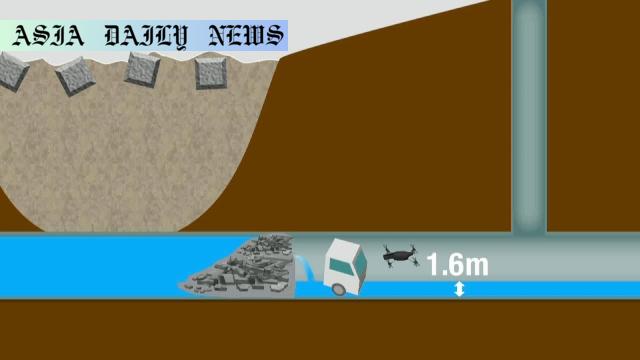Sinkhole claims truck cab in Saitama, urgent rescue unfolds.
Sinkhole developed in Saitama Prefecture, causing road collapse.
Truck cab likely containing driver located amidst sewage debris.
Rescue teams and safety experts face hazardous levels of gas in the area.
Japan’s infrastructure ministry enforces emergency inspections for other similar sewage pipes.

Sinkhole Tragedy Strikes in Saitama, Japan
A major sinkhole developed on January 28 in Saitama Prefecture, located north of Tokyo, leading to the collapse of a significant roadway. This tragic incident occurred when a truck fell into the unexpected sinkhole, and authorities now believe that the truck cab—with the driver inside—is submerged under layers of debris and contaminated wastewater beneath the site. Search and rescue efforts have been ongoing for the past two weeks, with teams using advanced tools like drones to locate and assess the scene.
Hazardous Rescue Operations
The conditions within the sinkhole area have made the rescue effort highly challenging. Drones sent into a sewage pipe beneath the site revealed a chaotic scene of wastewater, rubble, and gaps in collapsed asphalt. The sewage level, which is approximately 1.6 meters deep in some areas, has complicated the search. Additionally, the presence of toxic gases like hydrogen sulfide poses a severe risk to rescue workers. A former firefighter emphasized that the air quality inside the sewage pipe can be lethally dangerous, potentially causing death within one or two breaths. Specialized measures to reduce gas levels are necessary before firefighters or other emergency personnel can safely operate underground.
Infrastructure Issues and Broader Implications
This sinkhole incident has brought to light the vulnerabilities within Japan’s urban infrastructure. The government has reported similar cases of sinkholes appearing elsewhere, including one in Chiba Prefecture, where a 2-meter-wide hole emerged due to water leakage from a ruptured underground pipe. With these events occurring in quick succession, Japan’s Ministry of Land, Infrastructure, Transport, and Tourism has mandated emergency inspections in seven prefectures known to have comparable sewage systems.
Future Safe Practices and Developments
Authorities in Saitama have announced plans to install an upstream bypass pipe to divert wastewater away from the trapped truck cab. However, this critical infrastructure improvement will require up to three months to complete. In the meantime, efforts to mitigate the risks associated with hydrogen sulfide gas and other hazardous conditions are underway. Experts are advocating for stricter safety protocols and timely infrastructure maintenance to prevent similar events in the future.
Global Perspective on Infrastructure Susceptibility
Japan’s recent sinkhole challenges also highlight concerns that other nations face regarding older or compromised infrastructure. As urban centers continue to expand and stress aging systems, regular inspections, preventive maintenance, and use of advanced construction materials are becoming increasingly important. The tragic case in Saitama serves as a wake-up call not only for Japan but for countries worldwide to prioritize public safety when designing and maintaining critical infrastructure systems.
For the devastated community affected by the Saitama sinkhole, the incident underscores the unpredictable nature of infrastructure failures and the importance of proactive measures to address potential hazards. The ongoing rescue mission remains paramount, with all efforts geared toward recovering the driver and understanding the causes that led to this event.



Commentary
The Unseen Dangers of Urban Sinkholes
The sinkhole disaster in Saitama Prefecture strikes a nerve as it sheds light on both the immediate dangers these events pose and the underlying vulnerabilities in our urban infrastructure. It is a humbling reminder of how human engineering, despite all its advancements, can still falter when natural and man-made factors align unfavorably. For the driver believed to be trapped, the situation is heartbreaking, and effort must be intensified to recover them safely while minimizing risks to the crews involved.
Lessons for Urban Development
Infrastructure failures such as this incident compel authorities to act decisively not just in response to crises but also in prevention. Japan’s decision to inspect similar sewage systems in other prefectures is a proactive step in the right direction, but it also speaks to a broader, systemic issue. How often do we test aging systems to ensure they meet modern safety standards? The incident in Chiba Prefecture suggests that these problems may not be isolated, raising questions about risk management strategies nationwide.
Global Implications for Sustainable Growth
This tragedy resonates globally. Rapid urbanization and inadequate infrastructure investment can create ticking time bombs in many cities worldwide. Governments must allocate sufficient resources and expertise toward essential maintenance and adopt cutting-edge monitoring technologies. The loss of life or property resulting from preventable disasters should be a rallying cry for stronger policies and community involvement in urban planning.